Garden of Nero
1998.01.27
...Nero used Christians as human torches to light up his garden. ...Roman Catholic tradition/folklore. The Garden of Nero has "survived" throughout history more through text and memorable events than through physical evidence. ...evidence toward supporting the notion of the Ichnographia as a "reenactment", i.e., a narrative and a depiction, rather than a pure archeological "reconstruction".
The City of God - inverse ichnographia
1998.02.15
...The City of God, a connection between it and the Ichnographia. Sue Dixon mentioned a specific quotation where there is even a grammatical inversion used to describe the two natures of the city (the earthly vs. the spiritual). ...hopefully demonstrate how the Ichnographia represents both "urban" paradigms; the Ichnographia is a plan of earthly Rome and it is also an opposite/inverse plan of spiritual Rome. Piranesi was trying to deliver both messages, meaning he was aware of the two "urban" paradigms and thus used the "planning" of the Campo Marzio to express both.
...the time-frame of the Arch of Theodosius (the end of the Roman Campo Marzio), the Visigoth siege on Rome, and the subsequent writing of The City of God--these events occurred within a 40 year time-span. Piranesi was trying to depict, delineate, reconstruct, reenact the inversion from Imperial Rome to the spiritual Rome of the Church. Along with this line of thought there is also the not-so-smooth conversion of Rome from a pagan state to a Christian state.
Mistakes and Inversions
1998.02.19
...address Piranesi's own mistakes and inversions, particularly the inversion of the Circus Flaminius (which I now know to be also exchanged in location with the theater of Balba, which further shows Piranesi's intentional "mistakes" to make a specific point). [Perhaps,] Piranesi makes the mistakes, first to call attention to specific points, and second to highlight the notion of inversion. Piranesi is indeed being theatrical, which is only natural because of the whole notion of reenactment. ...discuss the Ichnographia's Triumphal Way and how Piranesi redesigns (reenacts) the Way making it more ideal to its purpose (marching through the theater district). The Way (within Ichnographia at least) ends at the Temple of Janus--a perfect example of inversion. Then following the Triumphal Way in reverse manifests the Christian theme of salvation and redemption, ending at the inverted "basilica"--the upside-down "inverted" crucifixion of St. Peter. ...the Ichnographia not only represents the history of ancient pagan city of Rome, but also the Christian city of Rome. This evokes Augustine's The City of God and also Bloomer's notion of the Ichnographia transcending time.
...the Scenographia as the stage upon which Piranesi reenacts--this is the first scene and the "play" is about to begin. In the course of the "play" the most egregious "mistake/inversion" is the misplacement and disorientation of the Circus Flaminius and its actual exchange with the Theater of Balba. This "mistake" manifests a composition of inverted theaters--essentially a double inverted theater. This configuration becomes one of the Il Campo Marzio's final scenes and thus represents the double inverted "theater" of Rome's own history--the narrative of pagan Rome and the narrative of Christian Rome, and in the Ichnographia the one story is indeed a reflection of the other.
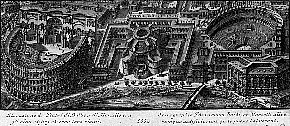
Encyclopedia Ichnographica
1998.07.04
Piranesi's Ichnographia Campus Martius, the large plan within the archeological text Il Campo Marzio dell'antica Roma, has inspired numerous architects since its first printing in 1757, yet the Encyclopedia Ichnographica is the first full-scale analysis of the plan's composition, meaning, and message. While representing a reenacted plan of ancient Rome's Field of Mars, Piranesi ingeniously delineates two narratives -- that of pagan Rome and that of Christian Rome -- and at the same time offers an unprecedented lesson in urban design.
Presented here as a work-in-progress, the Encyclopedia Ichnographica will address every detail of Piranesi's plan through an ongoing delivery of descriptive and analytical texts along with computer generated illustrations of the plan redrawn.
Romulus
1998.07.17
As the son of Mars, and as founder and first king of Rome, Romulus is synonymous with beginnings. Without Mars, however, Romulus is nothing, so it is through the concomitance of Mars and Romulus that the origin of Rome takes place in Piranesi's Campo Marzio.
The presence of Romulus within the Ichnographia occurs both directly and indirectly. There is the Templum Romuli, and there is the Templum novum Quirini. The Templum Romuli is within the Campus Martius proper, while the Templum novum Quirini is situated further east between the Horti Salustiani and the base of the Quirinal Hill. Both temples, interestingly enough, "preside" over large stadium complexes, and it is worth further noting that the Templum Romuli is on the same axis as one of the Ichnographia's two Templum Martis.
The third and most indirect reference to Romulus is the Lineae indicantes viam triumphalem--the line indicating the Triumphal Way--which begins in the Area Martis in front of the Ichnographia's other Templum Martis that is on the west bank of the Tiber within the Vatican valley. Each Roman Triumph, of which there were hundreds throughout ancient Rome's history, is a reenactment of the original triumphal march of Romulus. The Lineae. . .triumphalem of the Ichnographia therefore literally marks a lineage back to Rome's inception, and thus locates a point of beginning for the Ichnographia Campus Martius as well.
Petronia Amnis
1998.12.01
Although the Petronia Amnis did exist in ancient Rome, Piranesi dislocates the stream to a far more northern position. According to Platner, "there were several swamps or ponds in this low-lying district [the Campus Martius], as well as streams, the largest of which, the Petronia amnis, came from a spring on the Quirinal, called Cati fons, and flowed into the largest swamp, the palus Caprea, or Capreae, where were afterward the pool and baths of Agrippa."¹ There is no real satisfactory explanation why Piranesi chose to move the Petronia Amnis further north of its archeologically correct position, however, the dislocation fits within the same pattern whereby Piranesi moved the Equiria to a more northern position as well. It is as if Piranesi purposefully exaggerated the scope of the Campus Martius in order to present a more availing "reenactment" of Rome's past.
1. Samuel Ball Platner, The Topography and Monuments of Ancient Rome (Boston: Allyn and Bacon, 1904), p 322.
abstract done
1999.02.23 19:08
"Inside the Density of G. B. Piranesi's Ichnographia Campi Martii"
Albeit resolutely virtual, Piranesi's Ichnographia Campus Martius nonetheless manifests a high degree of density not only in terms of architecture and urbanism, but with regard to symbolism, meaning, and narrative as well. The hundreds of individual building plans and their Latin labels within the Campo Marzio do not "reconstruct" ancient Rome as much as they "reenact" it. Thus Piranesi's overall large plan presents a design of Rome that reflects and narrates Rome's own imperial history. Given Rome's history then, the ultimate theme of Piranesi's design is inversion, specifically ancient Rome's inversion from (dense) pagan capital of the world to (dense) Christian capital of the world--a prime example of the proverbial "two sides to every story."
With the inversion theme, Piranesi also incorporates a number of sub-themes, such as life and death, love and war, satire, and even urban sprawl. Rendered largely independent, each sub-theme relates its own "story." Due to their innate reversal qualities, however, each sub-theme also reinforces the main inversion theme. Piranesi's Campo Marzio is not only dense, it is condensed.
In 2001, the finished Ichnographia Campus Martius will be 240 years old, yet Piranesi's truly unique urban paradigm--a city "reenacting" itself through all its physical, socio-political, and even metaphysical layers--may well become the most real urban paradigm of the next millennium.
mistakes
1999.05.17
homo ludens and the Ichnographia
1999.07.14
There are certain passages within Homo Ludens that relate to Piranesi's "play" of the Ichnographia Campus Martius, especially with regard to reenactment, the Scenographia, and the double theater. There are also connections between ritual and play that relate to the Triumphal Way.
| |
reenactment
1999.11.09 10:28
When I first began to redraw Piranesi's Campo Marzio using CAD, I was doing so to get as close to Piranesi as possible; essentially, I was reenacting his act of drawing as best I could. For me, this exercise, this reenactment, has provided enormous insight albeit it took several years of continual work for this vision to develop. I am certainly not Piranesi, nor do I contend to possess his superior creative talent and imagination, but I deliberately attempted to do some of the same things he has done, and in so doing I honestly believe I removed several degrees of separation. Perhaps reenactments then are always a play with degrees of separation, sometimes seeing how close one can get to the 'original' and/or sometimes seeing how far one can "stretch the truth," to name the extreme cases.
sixth architectural reference
2001.01.04
R. James Aitken, Piranesi-Vico-Il Campo Marzio: Foundations and the Eternal City (Montreal: McGill University, 1995). This is Aitken's Master of Architecture thesis.
I first became aware of Aitken's thesis in late 1996 via an online publication of the thesis' abstract [www.mcgill.ca /arch /theory /marchabs .htm]. I did not read the thesis, however, until July 2000, that is, immediately after ordering the thesis through www.contentville.com [I just did a check at contentville and Aitken's thesis is oddly nolonger available there]. It was then that I again read the abstract and saw that Aitken's had already connected the notion of reenactment with Piranesi's large plan of Il Campo Marzio. What distressed me was that I had been by that time making much ado about Piranesi's Campo Marzio being a reenactment of the Pagan-Christian inversion of ancient/imperial Rome, yet I was doing so without any reference to Aitken's thesis. Of course, I really could not make any reference to Aitken's work simply because I had not read it, but that does not excuse the lacuna of my research and analysis. Henceforth, let it be clear that R. James Aitken is the first architect to identify Piranesi's Ichnographia Campi Martii as a reenactment.
Aitken also picks up on Piranesi's clues that the Campo Marzio is about Pagan Rome's conversion to Christianity, again a topic that I have been keen on. As with reenactment, however, Aitken is somewhat timid about his convictions in these regards, for the bulk of his thesis deals with the clear possible connection between Vico's "philosophy" and Piranesi's method. Plus Aitken stresses a reading of the Campo Marzio text along with a 'reading' of the large plan. In all, Aitken's thesis is very good, full of many valuable insights, and arguably the first full study of the Campo Marzio done with regard to the context of Piranesi's own time. Aitken's thesis does not follow Manfredo Tafuri's analyses of the Campo Marzio (as do Bloomer, Eisenman, and others), and thus Piranesi-Vico-Il Campo Marzio does not follow in the mistaken interpretations that Tafuri initiated.
With regard to my Campo Marzio research and 'thesis', it is somewhat uncanny that Aitken and I arrive at virtually the same conclusions, yet we come to the conclusions from distinctly different means. In fact, when you compare Aitken's thesis with the Campo Marzio material formerly published at www.quondam.com, our respective works virtually never repeat each other. Taken together, however, a new and cohesive understanding of Piranesi's Campo Marzio emerges.
The place where the bodies of the dead were burned and buried under Hadrian
2001.07.18
There is archaeological evidence that a street lined with tombs was once in this area of Rome during the Empire's latter centuries, and perhaps that is why Piranesi positions the sepulchers here. Beyond that reasoning, however, it could well be that the physical evidence of Hadrian's Tomb and Circus plus a street of sepulchers in the same area inspired Piranesi to here reenact a grand place of munus.
more of Piranesi's Campo Marzio
2001.07.01 09:05
You mentioned that you are not familiar with Piranesi's full Il Campo Marzio Dell'antica Roma publication. While its engravings are recently (and nicely) reproducted in both Wilton-Ely's and Ficacci's (Taschen) Piranesi: Complete Etchings, the texts that Piranesi wrote have to my knowledge never been republished (except for a facsimile publication of Il Camp Marzio by Borsi, 1972). The text is a history of the Campus Martius in both Latin and Italian, plus there is a list of extant ruins and a ' Catalogo', which is a bibliography of sorts -- what it does is list all the buildings that were in the Campo Marzio and matches them with their literary sources (both ancient and contemporary). Since I cannot read either Latin or Italian, the texts are for the most part inaccessible to me. The 'Catalogo', however, is for the most part discernable to me, and thus a great source into finding out what Piranesi was really up to when he 'reconstructed' (I refer reenacted) the Campo Marzio with the Ichnographia.
/reenactionary
2001.08.02
2. the crucifixion of St. Peter - the inversion of Christ's crucifixion; Porticus Neroniani as inversion of St. Peter's Basilica; is this the origin of Piranesi's overall inversionary reenactment theme? (It certainly could be.); this could certainly lead to the double theater of St. Peter's Square; the double inverted theaters of the Ichnographia; then the Bernini double play; the Baroque ending (for sure).
4 September 1997 and today
2001.09.04 11:00
Sometime in 1998 I learned of the Eugene J. Johnson article "What Remains of Man--Aldo Rossi's Modena Cemetery" in The Journal of the Society of Architectural Historians (March 1982), where Johnson adroitly demonstrates how Rossi's cemetery design closely compares with Piranesi's Bustum Hadriani as delineated within the Ichnographia of the Campo Marzio. What Johnson does not point out however, is that Rossi essentially reenacted the Ichnographia's axis of death which actually intersects the Ichnographia's demarcation of ancient Rome's Triumphal Way. Piranesi's plan delineations of the intersection of the axis of death and the Triumphal Way themselves manifest a reenactment of the ancient Roman camp/urban planned crossing of a cardo and decumanus.
back to the Campo Marzio
2001.09.08 16:50
Hello John,
...getting back to the two states of the Ichnographia, here are some further thoughts and questions:
1. I believe the first state is the plan as it is NOT published in books today. If you look at the smaller and earlier plans of the Campo Marzio within the plates prior to the Ichnographia, you will see earlier plans of the Circus Flaminius the same as the Circus Flaminus plan within the first state Ichnographia. Furthermore, the aerial view the Circus Hadriani within the frontispiece corresponds in plan with the first state Ichnographia.
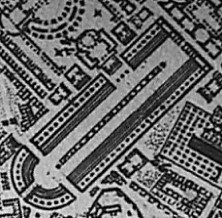 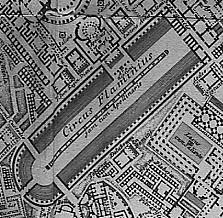
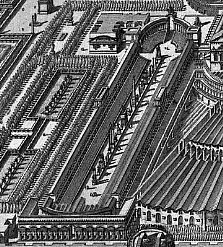 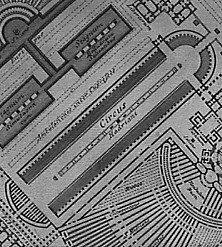
2. I think the circus delineations of the second state (which are all virtually identical to each other) are in fact delineations based on the Circus of Maxentius (rather than the Circus Maximus). This is somewhat significant in that (according to my research and interpretation of the Ichnographia as a double narrative relating Rome's inversion from pagan city to Christian city) Maxentius is exactly the ruler of Rome immediately prior to Constantine's Chistian efforts.
3. ...now knowledgable of the practice of damnatio memoriae, I wonder if Piranesi purposefully 'erased' portions of the Ichnographia as a reenactment of the damnatio memoriae practice, and, like some extant examples of dm inscriptions, if he then purposefully followed up with a palimpsest (of another plan) over the erasure.
4. I realized that I have yet to see an actual print version of the second state of the Ichnographia. All I've ever seen is an actual first state (1761) version. Do you know if you've seen an actual eighteenth cent. print version of the second state? Moreover, did you happen to make a trip to Rome to see which state the actual engraved plates are in? It is the current state of the plates that would surely identify the second state (that is, unless someone long ago altered a reproduction, and it happens to be an altered reproduction that's been printed in books all these years).
5. I also believe that it was indeed Piranesi that made the changes. My main reasoning here is that Piranesi was very likely the only person that could have made the changes with such dexterity.
As to Tafuri, I have documented so many cases within the Ichnographia that carried explicit meaning and message on Piranesi's part, that all of Tafuri's theorizing that the Ichnographia is indicative of and/or percursor to the modern meaninglessness of architectural form is plainly and emphatically wrong. What Tafuri obviouly never did, but definitely should have done, is to translate all the Latin labels that Piranesi applies to virtually all the plans of the Ichnographia. It is only through reading the labels and the planimetrics in combination that the full meaning of Piranesi's Campo Marzio comes through.
All the best,
Steve Lauf
|